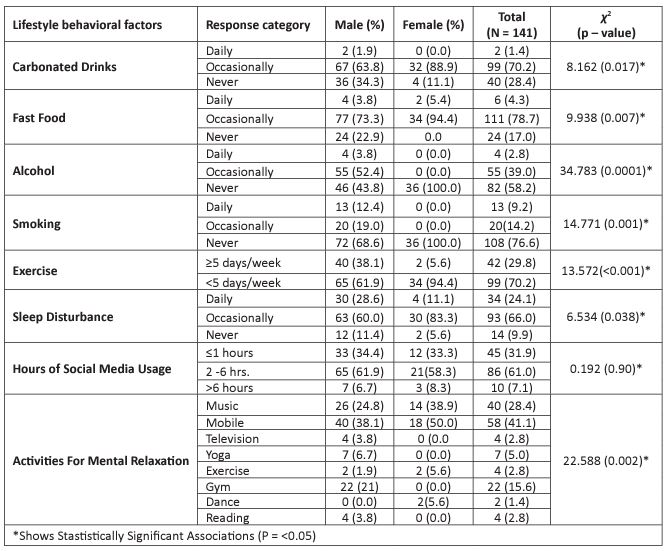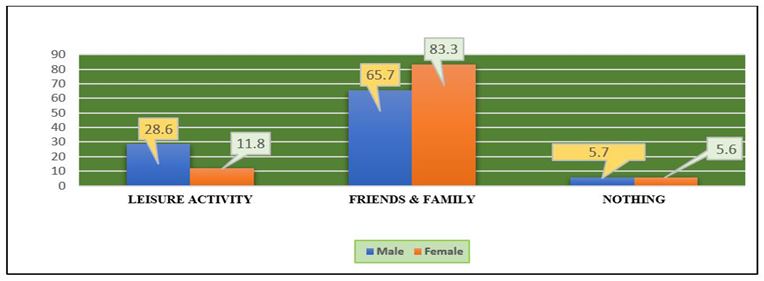Original Research Article - Volume 3 - Issue 2
Lifestyle behavior among Post - Graduate medical students in Jhalawar Medical College: A cross-sectional study
Anubhav Sharma1*; Shakila Mulla2
1PG Resident, Department of Community Medicine, JMC Jhalawar, India.
2Professor, Department of Community Medicine, JMC Jhalawar, India.
Received Date : Mar 14, 2023
Accepted Date : April 10, 2023
Published Date: April 17, 2023
Copyright:© Anubhav Sharma 2023
*Corresponding Author : Anubhav Sharma, PG Resident, Department of Community Medicine, JMC Jhalawar, India.
Email: dranubhav27@gmail.com
DOI: Doi.org/10.55920/2771-019X/1418
Abstract
Introduction: Lifestyle behaviour can be defined as the reactive, habitual, or intentional forms of human activity, which remain significantly intertwined with health. Non-communicable diseases (NCD) are determined to be increasing around the globe due to lifestyle-related behavioral risk factors including physical inactivity and dietary transitions such increased intake of high-fat and low-fiber diets. Medical students are prone to poor dietary habits, inactivity, lack of sleep, and the development of new habits like drinking alcohol and smoking. Since post-graduate medical students will eventually deliver healthcare, it is crucial to evaluate their lifestyle choices.
Aim: To assess the lifestyle behavior of post-graduate (PG) medical students and to compare lifestyle behavioral factors among different groups of PGs.
Methodology: Study design- Cross sectional study, Study period - Approximately 1 month, Study area - JMC, Jhalawar, Study population - All PG Residents batch 2020 and 2021, Study sample size - Complete Enumeration, Inclusion criteria - Residents who are willing to participate, Exclusion criteria - PGs on maternity leave or other leave, not returning filled proforma, refuse to participate. Study tools and materials - Predesigned and Pre-tested Proforma. Face-to-face interview while collecting proforma Data analysis - SPSS software 28.0 (trial version).
Result: A total of 141 post-Graduate medical students participated in the study. Out of which, 74.4% were males and 25.6% were females. Daily physical exercise is being significantly more practiced by males as well as alcohol intake and smoking is significantly associated with male students. 90.0% Students are facing disturbance during their sleep. Between 2 to 6 hours of social media use was found in 61% of students.
Introduction
Health behaviours can be defined as the reactive, habitual, or intentional forms of human activity, which remain significantly intertwined with health. Health behaviours include both ProHealth activities (e.g., healthy diet) and anti-health activities (e.g., cigarette smoking) [1].
Non-communicable diseases (NCD) are determined to be increasing around the globe due to lifestyle-related behavioral risk factors including physical inactivity and dietary transitions such increased intake of high-fat and low-fiber diets. Medical students are prone to poor dietary habits, inactivity, lack of sleep, and the development of new habits like drinking alcohol and smoking. Most of the available literature is on undergraduate medical students as compared to post graduate students. Since post-graduate medical students will eventually deliver healthcare, it is crucial to evaluate their lifestyle choices [1]’
According to the World Health Organization (WHO, Geneva, Switzerland) perspective, health is considered a resource in everyday living, not simply the absence of disease. Thus, research into younger people’s health needs to consider the positive aspects of health, as well as risk factors for future ill health and disease. Many behaviours that comprise young people’s lifestyles may directly or indirectly impact their health in the short and long term; consequently, a wide range of behavioral variables should be measured. Positive or health-promoting behaviours need to be studied, as well as health-damaging or risky behaviours [2]. AIM: To assess the lifestyle behavior of post-graduate medical students and to compare lifestyle behavioral factors among different groups [2].
Materials and Methods
Study design- Cross sectional study
Study period- Approximately 1 month.
Study area- Jhalawar Medical College, Jhalawar
Study population- All PG Residents batch 2020 & 2021 (total – 173 students)
Study sample-Complete Enumeration of PG Resident
Inclusion criteria- Residents who are willing to participate.
Exclusion criteria- PGs on maternity leave or other leave, not returning filled proforma, refuse to participate.
Study tools and materials- Predesigned and Pre-tested Proforma. Face-to-face interview while
collecting proforma
Study analysis- Microsoft Excel software and analysis by SPSS software.
A cross-sectional study was conducted among post-graduate medical students of Jhalawar Medical College, Jhalawar (Rajasthan). In this study we included All PG Residents batch 2020 & 2021 (total – 173 students). A predesigned, pretested self-administered questionnaire was used for collecting information from the study participants. It was prepared based on literature review and expert’s opinion. The printed questionnaire was distributed to the study participants in their free time.
The data entry was made in Microsoft excel sheet in codes. Data analysis was done using Statistical Package for Social Sciences (SPSS) software version 28.0 (trial version). Descriptive statistics were used to describe socio-demographic profile and lifestyle behavioral factors. Chi-square test was used to test the proportion between male and female for their lifestyle behavioral factors. A p-value <0.05 was considered as statistically significant.
Results
A total of 141 students participated in the study. Out of the 141 study participants, 36 (25.5%) were females and 105 (74.5%) were males. There were 106 (72.2%) hostellers and 35 (24.8%) were residing in rental houses. Lifestyle behavioral factors and the gender-wise comparison are presented in Fig-1. Dietary pattern showed Consumption of carbonated drinks and fast foods shown in students who consume “occasionally” were 70.2% and 78.7%, respectively males & females. Alcohol intake was present only in male students 59.1% out of which 3.8% consuming “daily” & 52.3% consuming “occasionally” (p value < 0.0001). 31.4% of male students found smokers (p value - (0.001). We found statistically significant association of gender with exercise (p value 0.001). Out of 141 students, 29.8% of students doing exercise more than 5 days / week where 95.3% were males & 4.7% were females & students who are doing exercises less than 5 days/week were 70.2% where 65.7% were males & 34.3% were females. Students who are facing disturbance during their sleep were (including daily & occasionally sleeping time) 127 out of 141 students; out of which males were 93 (88.5%) & females 34 (32.3). p value – 0.038 shows significant association of gender with sleep disturbances. Majority of students use social media for 2 to 6 hours 86 (61.0%). Out of 86 students, 75.6 % were males & 24.6% were females. Activities done by students for mental relaxation was analyzed & found statistically significant association “P value 0.002.” Majority of students 58 (41.1%) out of which 69% males & 31% females use mobile phone for their mental relaxation. 40 students (65% males & 35% females) enjoy music for their mental relaxation. Television, Yoga, Gym & Reading respectively 2.8 %, 5.0 %, 15.6 %, & 2.8 % done only by male students. Where 1.4% of female students use dance as an activity of mental relaxation.

Figure 1: Gender-wise Association of Lifestyle Behaviors.
Table 1: Gender-wise Association of Lifestyle Behaviors.


Figure 2: Activities being missed after joining PG
Table 2: Association of duty hours with Clinical and Non – Clinical Departments

Figure 2 reveal that most of study participants 99 (males 69.7% and 30.3% females) were missing friends and family. 34 students were missing their leisure activities including males 88.2% and 11.8% females and out of 141 students, only 8 students (75% males and 25% females) were missing nothing after joining PG.
Students of clinical departments having more duty hours as compared to non- clinical departments. This difference in duty hours shows statistically significant association with departments (p <0.0001)
Discussion
A cross-sectional study was conducted among post-graduate medical students of a Jhalawar Medical College in Jhalawar (Rajasthan). In our study we found consumption of unhealthy foods like carbonated drinks and fast foods respectively 71.6% & 82.9% were found among our PG residents which is not a favorable trend. Similar study was conducted by Rustagi N et al found that consumption of carbonated drinks (23.7%) and fast food (32%) intake were noted among medical students in Delhi which was lower than the present study [3].
In our study we found 29.8% of our PG residents are doing exercise more than 5 days a week which is higher than the study conducted by R Anuradha et al, they found 28% of students doing exercises more than 5 days a week [4].
In present study we found 39.7% PG residents consuming alcohol. A study conducted by Vorster A et al found consumption of alcohol by students was 78.9% which is higher as compared to our study [5].
This is a cross-sectional study conducted only in one medical college which may limit the generalizability of the findings. Since the responses were collected using self-administered questionnaire, so there may be information bias.
Conclusion
Behaviour risk factors such as unhealthy diet, irregular eating habits, and physical inactivity were prevalent among the medical PGs.
References
- Lesińska-Sawicka M, Pisarek E, Nagórska M. The Health Behaviours of Students from Selected Countries-A Comparative Study. Nurs Rep. 2021 May 31;11(2):404-417. =
- Currie C. The international HBSC Study: Rationale, history and description. In: Currie C., Hurrelmann K., Settertobulte W., Smith R., Todd J., editors. Health and Health Behaviour among Young People. Health Behaviour in School-aged Children: A WHO Cross-National Study (HBSC) International Report. World Health Organization Regional Office for Europe; Copenhagen, Denmark: 2000.
- Rustagi N, Taneja D, Mishra P, Ingle G. Cardiovascular Risk Behavior among Students of a Medical College in Delhi. Indian J Community Med. 2011; 36(1): 51-3.
- Anuradha R, Priyadharshini S, Patil A. Lifestyle behaviour among undergraduate medical students in Tamil Nadu: A cross-sectional study.
- Vorster A, Gerber AM, van der Merwe LJ, van Zyl S. Second- and third-year medical students' self-reported alcohol and substance use, smoking habits and academic performance at a South African medical school. Health SA. 2019; 24:1041.

